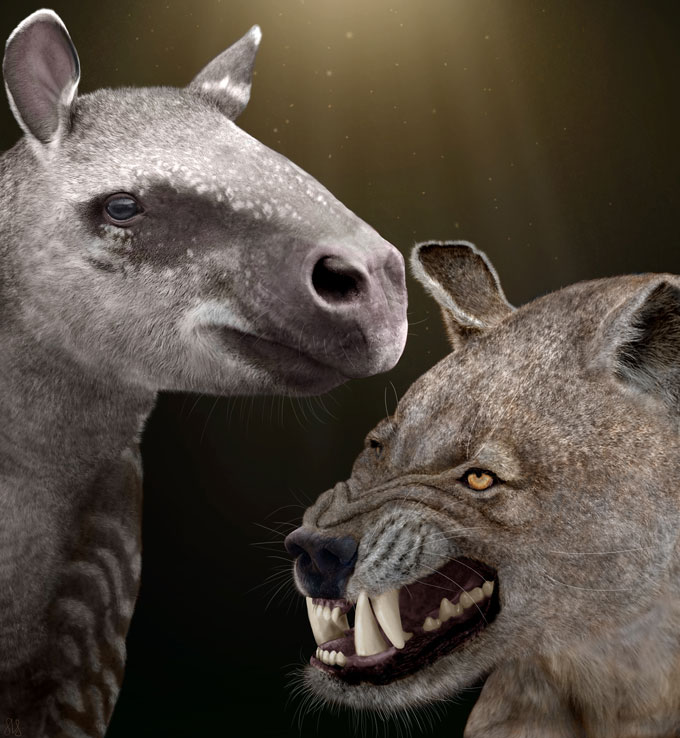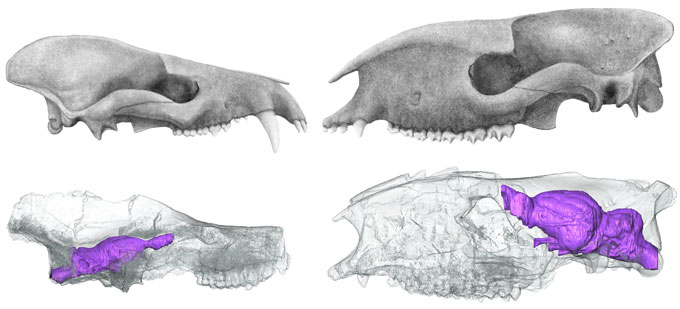This post was originally published on this site
Modern mammals are known for their big brains. But new analyses of mammal skulls from creatures that lived shortly after the dinosaur mass extinction shows that those brains weren’t always a foregone conclusion. For at least 10 million years after the dinosaurs disappeared, mammals got a lot brawnier but not brainier, researchers report in the April 1 Science.
That bucks conventional wisdom, to put it mildly. “I thought, it’s not possible, there must be something that I did wrong,” says Ornella Bertrand, a mammal paleontologist at the University of Edinburgh. “It really threw me off. How am I going to explain that they were not smart?”
Modern mammals have the largest brains in the animal kingdom relative to their body size. How and when that brain evolution happened is a mystery. One idea has been that the disappearance of all nonbird dinosaurs following an asteroid impact at the end of the Mesozoic Era 66 million years ago left a vacuum for mammals to fill (SN: 1/25/17). Recent discoveries of fossils dating to the Paleocene — the immediately post-extinction epoch spanning 66 million to 56 million years ago — does reveal a flourishing menagerie of weird and wonderful mammal species, many much bigger than their Mesozoic predecessors. It was the dawn of the Age of Mammals.

Before those fossil finds, the prevailing wisdom was that in the wake of the mass dino extinction, mammals’ brains most likely grew apace with their bodies, everything increasing together like an expanding balloon, Bertrand says. But those discoveries of Paleocene fossil troves in Colorado and New Mexico, as well as reexaminations of fossils previously found in France, are now unraveling that story, by offering scientists the chance to actually measure the size of mammals’ brains over time.
Bertrand and her colleagues used CT scanning to create 3-D images of the skulls of different types of ancient mammals from both before and after the extinction event. Those specimens included mammals from 17 groups dating to the Paleocene and 17 to the Eocene, the epoch that spanned 55 million to 34 million years ago.
What the team found was a shock: Relative to their body sizes, Paleocene mammal brains were relatively smaller than those of Mesozoic mammals. It wasn’t until the Eocene that mammal brains began to grow, particularly in certain sensory regions, the team reports.
To assess how the sizes and shapes of those sensory regions also changed over time, Bertrand looked for the edges of different parts of the brains within the 3-D skull models, tracing them like a sculptor working with clay. The size of mammals’ olfactory bulbs, responsible for sense of smell, didn’t change over time, the researchers found — and that makes sense, because even Mesozoic mammals were good sniffers, she says.
The really big brain changes were to come in the neocortex, which is responsible for visual processing, memory and motor control, among other skills. But those kinds of changes are metabolically costly, Bertrand says. “To have a big brain, you need to sleep and eat, and if you don’t do that you get cranky, and your brain just doesn’t function.”

So, the team proposes, as the world shook off the dust of the mass extinction, brawn was the priority for mammals, helping them swiftly spread out into newly available ecological niches. But after 10 million years or so, the metabolic calculations had changed, and competition within those niches was ramping up. As a result, mammals began to develop new sets of skills that could help them snag hard-to-reach fruit from a branch, escape a predator or catch prey.
Other factors — such as social behavior or parental care — have been important to the overall evolution of mammals’ big brains. But these new finds suggest that, at least at the dawn of the Age of Mammals, ecology — and competition between species — gave a big push to brain evolution, wrote biologist Felisa Smith of the University of New Mexico in Albuquerque in a commentary in the same issue of Science.
“An exciting aspect of these findings is that they raise a new question: Why did large brains evolve independently and concurrently in many mammal groups?” says evolutionary biologist David Grossnickle of the University of Washington in Seattle.
Most modern mammals have relatively large brains, so studies that examine only modern species might conclude that large brains evolved once in mammal ancestors, Grossnickle says. But what this study uncovered is a “much more interesting and nuanced story,” that these brains evolved separately in many different groups, he says. And that shows just how important fossils can be to stitching together an accurate tapestry of evolutionary history.